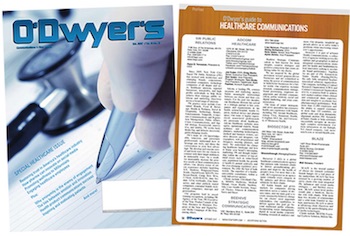|
|
While significant legislative battles are being fought, healthcare organizations are preparing to adapt to a new way of life, and it isn’t clear what that will look like. As a result, new positioning, messages, and many outreach activities have been reconfigured to meet the new demands of a volatile, ever-changing healthcare environment. The examples below demonstrate how this movement is affecting the demands made on communications professionals.
• One nonprofit undertook an extensive rebranding process and created new positioning and messaging. They reoriented the entire organization to be ready to lead in an entirely new era of health and healthcare.
|
|
• A medical society is trying to make sure it has a seat at the table and is regarded as a critical member of the care team, as clinics, hospitals, and technology combine to alter care-delivery to meet the needs of their patients, whenever and wherever they want and need care.
• CEOs are being challenged by their boards to become a national voice for their organization. They are engaging more in thought-leadership activities and speaking up on policy matters.
• A professional association is making sure the C-suites of hospitals and health systems recognize and value their role in improving care and reducing costs. Otherwise, they face being replaced with a perceived lower-cost alternative or having those services eliminated altogether.
We’ve seen the focus of communications activities evolve to meet the new demands of the healthcare marketplace. It’s certainly an exciting time, and one that requires PR professionals to take a candid look at the role they play within their organization and make sure they are ready to meet the communications demands of a new healthcare world.
Taking the pulse of PR professionals
To learn more about how the changing environment is affecting workloads and to understand how communications experts are preparing for 2018, we surveyed members of the Public Relations Society of America, and are eager to share what we found.
2017 has emerged as the year when more communications professionals are being asked to do more. More than one-third of PR professionals report an increased workload and approximately one in 10 say their workload is in a constant state of change because of the political environment. No one said their workload has decreased.
Many are being asked to provide ROI projections to justify the investment of time and resources by leadership and subject-matter experts. These findings lead one to believe our jobs are becoming more challenging and not necessarily more appreciated. One survey respondent worries about “diluting the definition and value of PR as a strategic process to influence specific people …” Another said, “We increasingly have to be our own reporters in a noisy world.” Another said the “perception of PR being free and easy” makes it difficult to do our jobs.
The current environment is affecting how PR people expect to spend their time in 2018. Social media, messaging, and issues management are the top three growth areas, followed by thought-leadership, consumer education, and research. The power of social media is growing and the demand for clear, concise, and targeted messaging has never been greater. Limited time and the barrage of competing information sources are forcing our industry to spend more time using fewer words, for a highly segmented audience.
Time spent on earned media, advocacy, and branding are expected to decline in the coming year. This was surprising and brings into question if the growing competition for share of voice in the media and among policymakers is partly to blame. It’s becoming increasingly challenging to stand out in the always-on news cycle and amidst the gridlock of legislation.
PR people are worried about the economy, and for varying reasons. One person alluded to the surge economy driving up demand for PR services. Others voiced concerns about a possible looming recession and the reduction of federal monies that fund healthcare campaigns and their communications budgets.
Many of these changes are to be expected, and being asked to do more with fewer resources isn’t a new challenge for our field. However, what we are tasked to do on a day-to-day basis is changing. It has become increasingly challenging to place earned media stories. As a result, PR professionals are turning to content amplification and marketing strategies to develop and place their own content. These are often paid services, and sometimes the impact is questionable. Does reaching 100 million people through a paid content strategy have the same impact as an earned media placement?
Five skills for 2018
As communications professionals’ roles change, is your team ready to meet the new demands? Below are five areas to focus on in the coming year.
• Grow your organization’s social media presence
• Prepare to respond to emerging issues
• Build content-marketing expertise
• Seek new groups to partner with on outreach
• Do more with limited resources
Several survey respondents voiced concerns about the mounting pressure to demonstrate ROI through PR. Showing true impact often requires a significant investment for research dollars. But let’s face it, many teams don’t have those kinds of budgets. So, what can do you in lieu of big dollars? Creating dashboards that outline key metrics and track success toward goals are highly effective and resonate with client leadership. These one-page visually-appealing charts communicate important information quickly and succinctly to organizational leaders who have very little time to spend reading through massive amounts of stories, posts, and reports. Agreeing on the process measurements up front, you can report the number of original and syndicated stories, weekly impressions, engagements, shares, message uptake, frequency of organization’s name-mentions, tone, and inclusion of brand values. Dashboards are essential for every project team and department.
If 2017 has been a year of increased workload, then 2018 will be the year of figuring out how to stay “present” on a range of communications channels and report the impact you are having for the organization. If you can’t measure it, you probably shouldn’t do it.
***
Sharon M. Reis is Principal and Tamara P. Moore is a Vice President with The Reis Group.

 Sharon M. Reis and Tamara P. Moore co-authored this article.
Sharon M. Reis and Tamara P. Moore co-authored this article.

 Lo Isidro, senior director at Real Chemistry with more than a decade of strategic communications and PA experience, has joined Narrative Strategies.
Lo Isidro, senior director at Real Chemistry with more than a decade of strategic communications and PA experience, has joined Narrative Strategies. Nelson Fernandez, former North American chair of APCO Worldwide and managing director of Burson-Marsteller, has joined Volunteers in Medicine Berkshires as director of communications and PA.
Nelson Fernandez, former North American chair of APCO Worldwide and managing director of Burson-Marsteller, has joined Volunteers in Medicine Berkshires as director of communications and PA. Lilit Bargar, who was most recently an EVP in the healthcare practice at Weber Shandwick, comes on board at GCI Health as EVP, corporate practice lead.
Lilit Bargar, who was most recently an EVP in the healthcare practice at Weber Shandwick, comes on board at GCI Health as EVP, corporate practice lead.
 Five ways that successful thought leaders are made.
Five ways that successful thought leaders are made.


 Have a comment? Send it to
Have a comment? Send it to 
No comments have been submitted for this story yet.